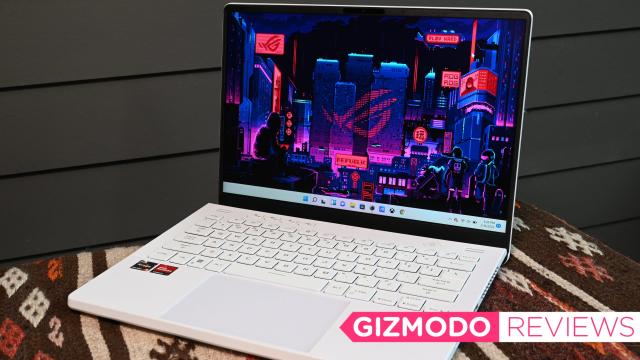Who doesn’t love a hero story? Asus’s ROG Zephyrus G14 is the protagonist of AMD’s recent resurgence. When the original model arrived a few years ago, it proved Ryzen processors could outmuscle Intel chips while delivering class-leading runtimes. For Asus, its symbiotic relationship with Intel’s rival gained it a standout portable gaming system that struck a perfect balance between size, performance, and efficiency. The ROG Zephyrus G14 was met with critical acclaim and became so popular commercially that it would sell out for months at a time.
This year’s model doesn’t change the winning recipe, but rather refines each of the ingredients. Asus listened to feedback and aggressively tackled past shortcomings by enhancing existing features like the touchpad and cooling while also debuting new ones, including an RGB-backlit keyboard, a 16:10 display, and an IR webcam.
But for all the changes made to the design, the highlight remains the G14’s twin-turbo engine consisting of an AMD Ryzen 9 6900HS CPU and a Radeon RX 6800S GPU. Yes, this year, the G14 wears red from head to toe. If you were worried Asus was taking a risk by leaving out Nvidia, don’t be: The Zephyrus G14, though not perfect, is better than ever.
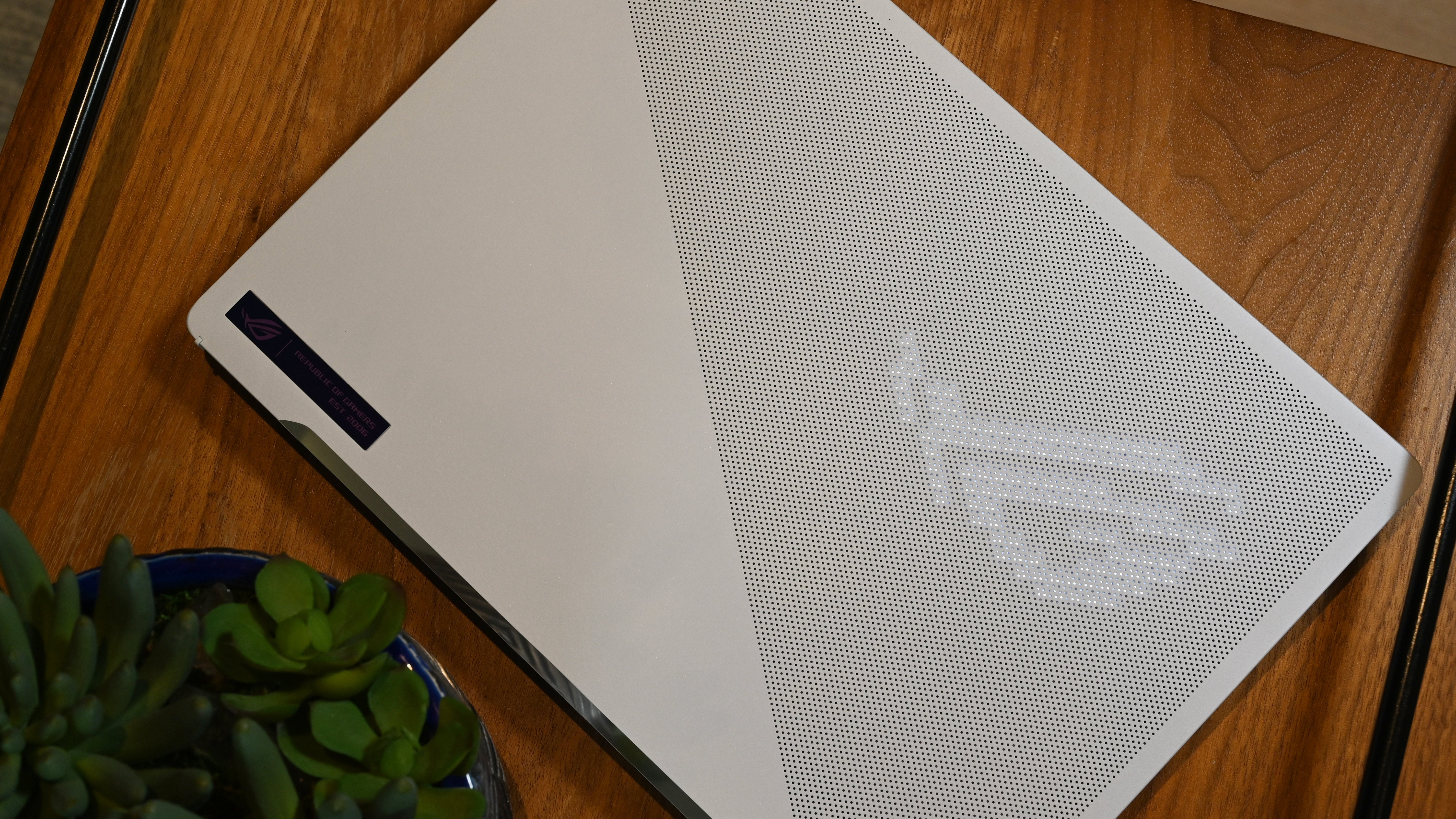
Asus ROG Zephyrus G14 (2022)
What is it?
A portable 14-inch gaming laptop
Price
Starts at $US1,599 ($2,220) ($US2,499 ($3,469) as reviewed)
Like
Excellent performance; attractive portable design; strong port selection; bright, colourful 16:10 display; larger touchpad; now with (optional) RGB keys; it has a webcam!
Don't Like
Runs warm; top configs get pricey; webcam could be better; uneven backlighting
Elegance Can Be Fun
The Zephyrus G14 looks almost identical to the previous version, which means it’s just as eye-catching, especially the Moonlight White model Asus sent me. (Eclipse Grey is the other option.) I’m impressed by the balance Asus struck: The Zephyrus G14 can spread its feathers for gamers who want something flashy then dial things back when a subdued appearance is more appropriate, like in a classroom or office.
This transformation depends on the features you choose when configuring your system. Some are less subtle than others, like the bonkers dot-matrix covering most of the lid. Now packed with more LEDs (1,449 to be exact), the AniMe Matrix consists of a grid of white lights that can display custom animations. When disabled, it gives the lid an attractive stippled pattern; turn the LEDs on and the people around you are treated to a fascinating light show. There is a refreshing lightheartedness that abides by Asus’s “for the hell of it” design approach. And surprisingly, it works.

Though gimmicks like this aren’t usually my cup of tea, I had fun playing with the glowy dots. The minute or so it took to change the animation from a meteor shower to an exploding heart on Valentine’s Day was worth my wife’s supportive half-smile when I boldly lifted the lid next to her. I’m a dork, I know, but hey, at least I won her over. If that wasn’t quirky enough, you can now place Asus’s Omni virtual pet on the lid and challenge it to mini-games.
Also on the snow white lid is a reflective pink “Republic of Gamers” emblem just above a chrome strip. Open the laptop under the right lighting and you’ll notice that the keys and deck have a pearlescent sheen that sparkles turquoise blue and pink. While easily ignored, these elements add a certain passive elegance to the chassis. You have to flip the laptop around and upside down to spot its gaming origins. There, you’ll find aggressive contours and slanty angles — the sort of Cyberpunk style synonymous with Zephyrus laptops.
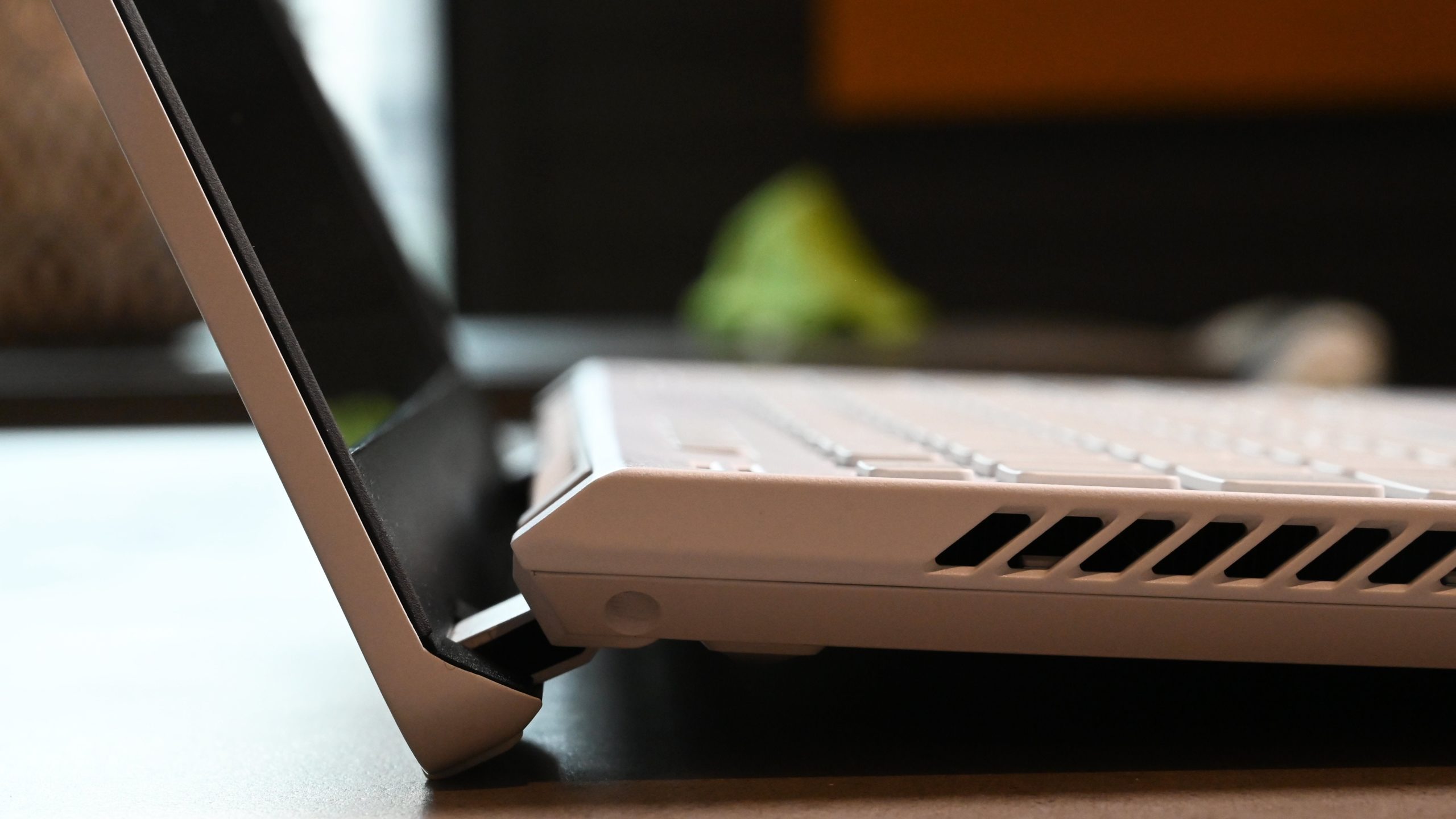
There are some nice quality-of-life elements here that I didn’t notice before getting my hands on the Zephyrus G14. The front lip is angled downward, which makes it easier for you to lift the screen with one hand. And when the lid is fully opened, the laptop rests on an “ErgoLift” hinge that folds under the base. This puts the deck at a more comfortable typing angle and improves airflow. Also, the hinge now rotates 180 degrees so the screen goes flat — laptop makers call this a collaboration feature but I personally like the reassurance of knowing the lid won’t snap off when I push it back too far.
My favourite design updates can be found around the display. This year’s Zephyrus G14 retains the slim bezels of its predecessor but finds space for a front-facing camera above the screen. Oh, and that screen is now in a 16:10 aspect ratio, which gives you more vertical viewing space and makes this already portable system feel even more compact. Indeed, the Zephyrus G14 is slim and lightweight at 12.3 x 8.9 x 0.73 inches and 2 kg; I barely noticed the machine in my backpack when I brought it to a cafe.
Larger Touchpad, RBG Keys
Asus listened to complaints about the size of the touchpad and took them seriously. On this model, the surface is both taller and wider, resulting in a 50% overall size increase. The glass rectangle, which has a slightly rubbery feel, is one of the best I’ve used on a gaming laptop and responded quickly to my swipes and gestures.
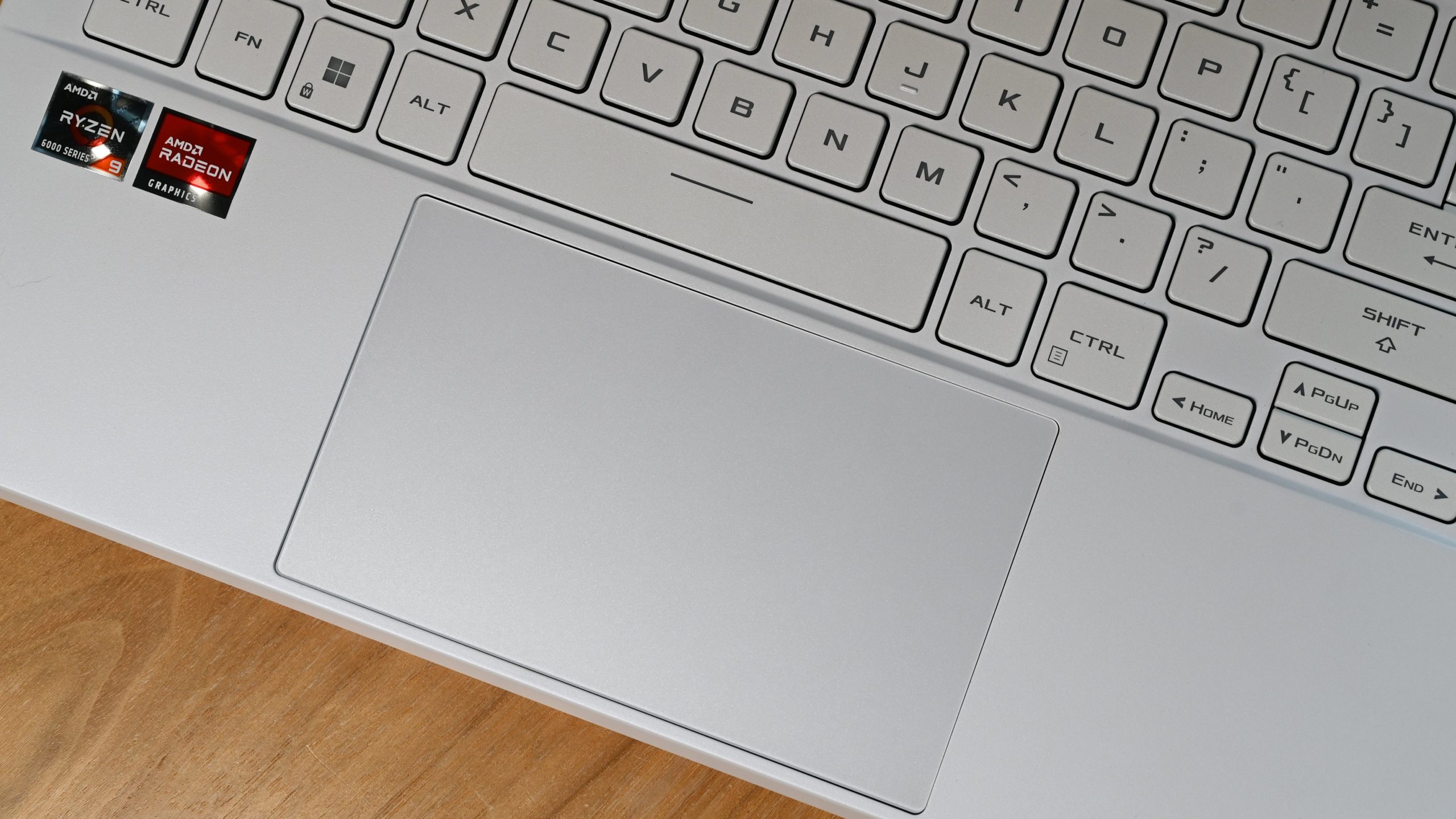
The keyboard was also tweaked, though the overall typing experience hasn’t changed much. Gone is the sci-fi aesthetic and in its place is something more traditional. These aren’t the clickiest keys but the generous 1.7mm travel and goldilocks size and spacing made me feel right at home from the moment I started typing. For quantitative proof, I typed at a well-above-average 119 words per minute with a 97% accuracy on a standardised typing test. I also like how Asus offset the arrow keys into an inverted T and set aside a row of communication keys (volume, mute) at the top of the deck for easier access.
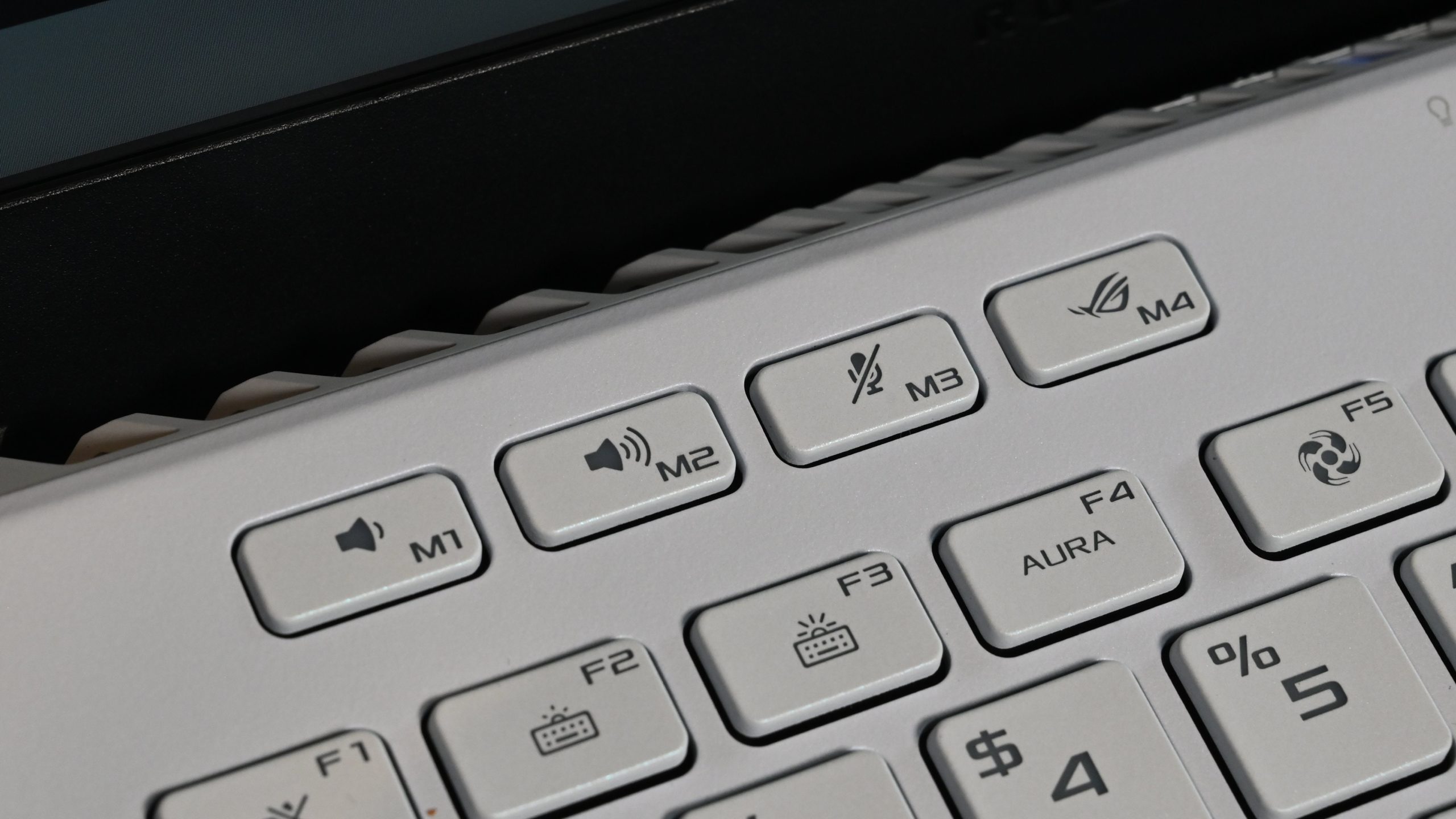
Gamers will appreciate the addition of an RGB keyboard option. Sadly, my review unit has white keys (we’ll chat later, Asus) so I can’t show you what I’m sure will be a glorious light show against this white backdrop. I’ll get over the omission. What I’m more offended by is the uneven backlighting, one of the few gripes I have with hardware that otherwise nails the details. If you opt for the RGB version, those hues can be customised in Asus’s Armory Crate software. And just a quick word on apps: Asus’s pre-installed software is some of my favourite. The company does a good job of combining useful features into one or two apps and presenting them with modern, colourful interfaces.
I’ve only scratched the surface of what the Zephyrus G14 has going in its favour. The quad speakers — consisting of two upward and two downward-firing drivers — get loud and sound crisp while delivering a surprising thump in the lower frequencies. The 720p webcam doesn’t take the best photos or videos but it’ll do in a pinch, and the IR sensor that enables facial recognition makes logging into the Zephyrus G14 near-instant.

Then there is the generous array of ports for a laptop of this size. You’ve got two USB 3.2 Type-A inputs for plugging in peripherals, a pair of USB 3.2 Gen 2 USB-C ports split among each side, an HDMI 2.0b input on the left, a microSD card slot on the opposite side, and a headphone/mic jack. I can’t in good faith request an Ethernet port in such a compact machine but I wish Asus had at least included a dongle. Worth noting here is that the USB-C on the left side, which supports 100W power delivery and DisplayPort, is USB4 capable but won’t get full functionality until a software update arrives later this year, Asus promises.
A Better Display in Every Way
The 14-inch display on the previous model was good — now it’s great. We can say an unceremonious farewell to the 16:9 aspect ratio and a wholehearted hello to a 16:10 panel. I prefer the taller, narrower shape because it feels more spacious when viewing multiple windows side-by-side and when scrolling down web pages. This 2560 x 1600 (WQXGA) IPS panel is also brighter than before and drops the response time from 25 milliseconds to just 3ms.
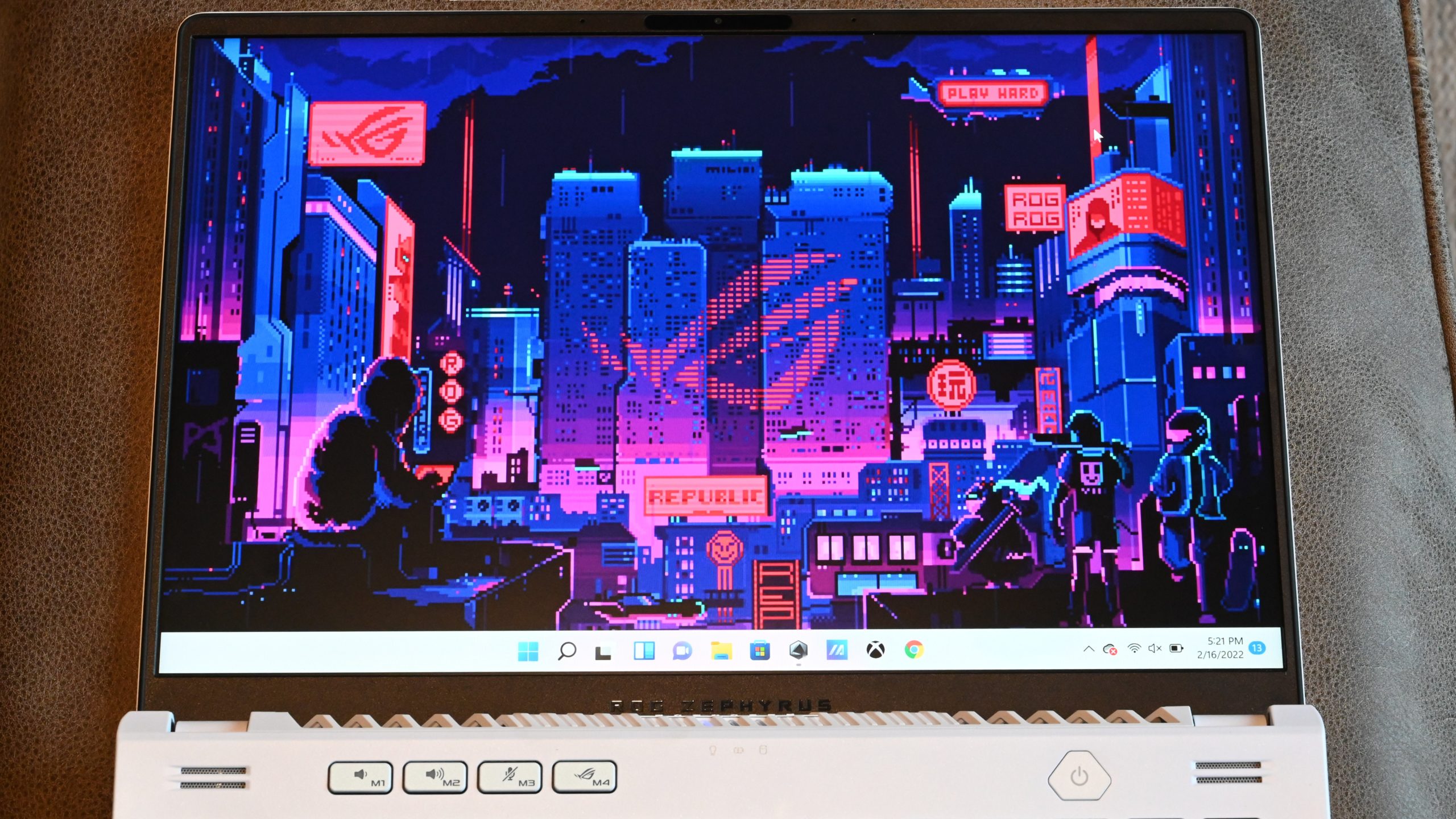
The panel checks all of the boxes. It’s bright, colourful, has a 120Hz refresh rate, supports Dolby Vision, is Pantone validated to have accurate colours, and is certified for low blue light emission to reduce eye strain. What you really want to know is: yes, it is that good in practice. In fact, it holds its own when compared side-by-side with an OLED-equipped laptop I’m currently reviewing. Obviously, the matte panel isn’t as colourful but there is plenty of pop and I measured a max brightness of 530 nits, which is significantly brighter than the 300-nit panel on the previous model.
AMD in Harmony
Now, for the main event: Not only is the Zephyrus the first laptop equipped with an AMD Ryzen 9 6900HS CPU, but it’s now part of a rare breed of gaming laptops that opts for AMD GPUs rather than Nvidia chips. Where the previous model maxed out at a GeForce RTX 3060 GPU, this 2022 version goes up to a Radeon RX 6800S — a high-end discrete GPU AMD revealed at CES last month.
Our review unit was configured with an AMD Ryzen 9 6900HS CPU (8 core/16 thread) with 32GB of DDR5 RAM, and a 1TB PCIe 4.0 SSD. No barrage of Chrome tabs, Twitch streaming, or photo editing could slow the G14, which did an equally excellent job on our synthetic benchmark tests. The results are quite staggering.
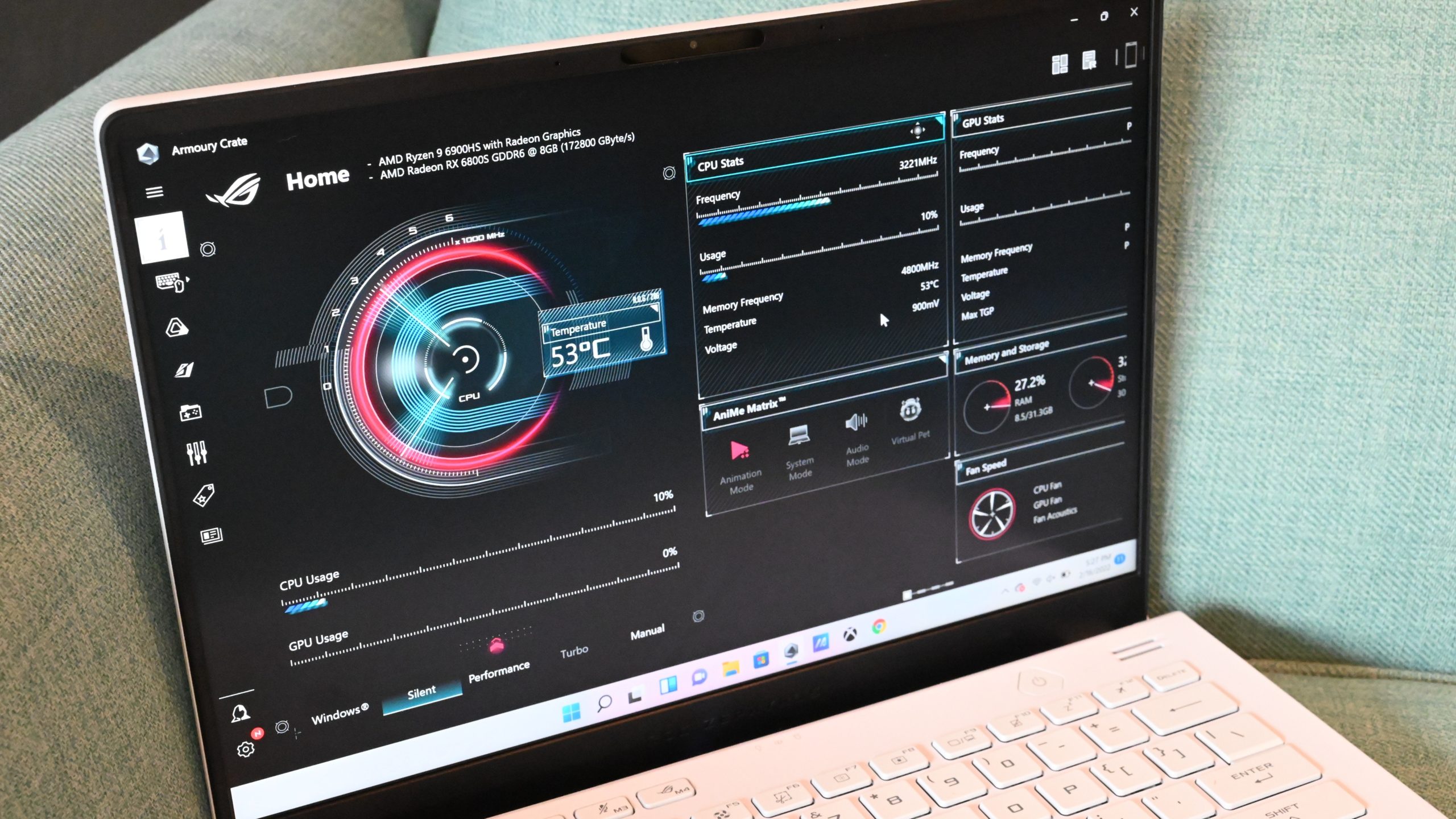
On the Geekbench 5 overall performance test, the Zephyrus G14 scored 1,552 and 10,002 for single and multi-core, respectively. Those results handily defeat last year’s Razer Blade 14 (7,403) and Alienware 15x (9,339) but fall short of the mighty MacBook Pro 14 (12,663). The previous G15 with a Ryzen 9 5900 CPU scored in the low-8,000 range. The only laptop I had on hand with Intel 12th Gen chips, an Asus ROG Strix SCAR 17 (review coming soon) with a Core i9-12900H CPU, scored a delicious 12,903.
It took the Zephyrus G14 3 minutes and 15 seconds to convert a 4K video to 1080p resolution, a result that outpaces nearly every laptop we’ve tested short of the Alienware 15x, which completed the task two seconds faster. The Razer Blade 14 (3:48) and MacBook Pro 14 (3:21) were close behind the Asus and Alienware.
Shifting to graphics performance: The Zephyrus G14 held its own against systems equipped with Nvidia RTX 3070 chips. In total, the G14 drives 105W of graphical power thanks to the AMD-exclusive SmartShift and SmartAccess Memory features, which allocate power to where it is most needed. It also has a MUX switch, a microchip that allows the dedicated GPU to bypass the CPU on its way to the display. This way, it can push frames directly to the screen, resulting in reducing latency and boosting framerates by up to 9%, according to Asus.

In Far Cry 5 on Ultra setting at 1920 x 1200 resolution, the Zephyrus G14 averaged 94 frames per second, falling just below the Alienware x15 (106 fps) with an RTX 3070 running the game at 1080p. The Razer Blade 14 with an RTX 3070 hit 100 fps.
On the Total War: Warhammer II benchmark, the Zephyrus G14 maintained 68 fps, edging out the Predator Triton 300 SE (66 fps) with an RTX 3060 GPU but only notched a frame above its predecessor.
And in Metro Exodus on Ultra, the AMD GPU averaged 68 fps, a few frames above the previous model (66 fps) and Razer Blade 14 (65 fps) but short of the Alienware x15 (75 fps). The Alienware m15 R5 with a Ryzen 7 CPU and RTX 3060 GPU stopped well short of its competitors, averaging only 50 fps.
Still Runs Warm
Asus gave me a — count ‘em — 77-page reviewer guide, much of which talked about the new cooling system. It felt like I was reading an engineer’s technical whitepaper. I’ll spare you the gory details and give you the TL;DR version: more fan blades (84 up from 71) with a unique tapered design, four heat pipes, a vapour chamber; and liquid metal, a compound from Thermal Grizzly for better conductivity than standard thermal paste. It is also the first ROG laptop with dust filters to prevent grime from clogging things up. Asus’s own testing showed the filter kept CPU and GPU temps at about four degrees below the same unit without the filter while allowing those components to draw more power.
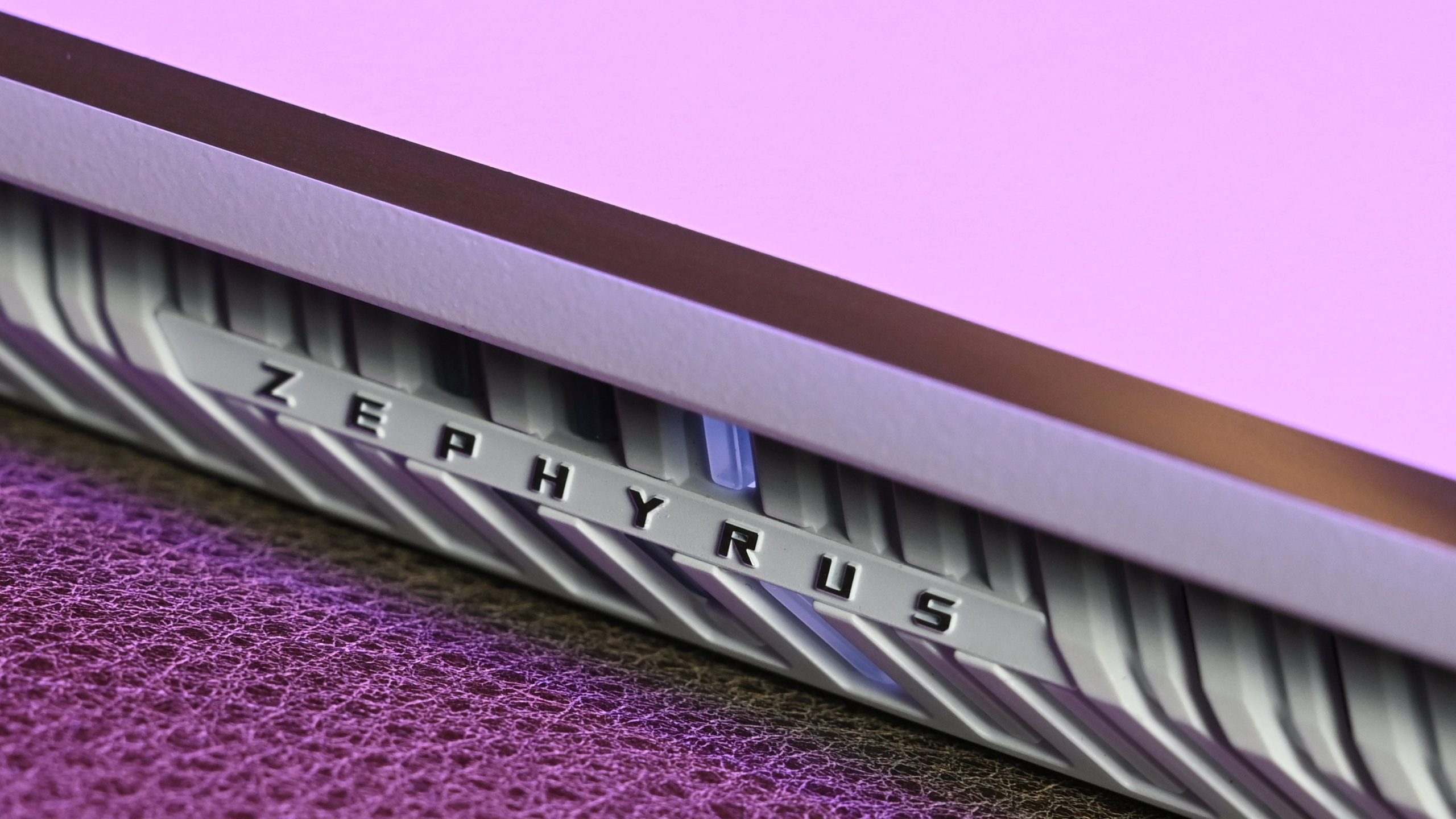
For all the effort Asus put in, the Zephyrus G14 still prefers warm climates. The laptop was perpetually lukewarm throughout my everyday workflow and quite toasty during gameplay. That said, the temps never reached worrying levels, though I wouldn’t keep the G14 on my lap when playing Crysis.
One benefit of these new thermals is something Asus calls 0db mode, which turns off the fans when the laptop is under a normal load, making it pin-drop silent. That much, I love. At least, until the keyboard got hot while the fans remained dormant. I measured a lukewarm 104 degrees on the keys when only one window was open. The fans eventually kicked on after I pulled up another few dozen tabs — which the Zephyrus loaded in a flash, by the way — but even then, the keyboard had risen a few degrees.
Battery Life in a League of Its Own
The Zephyrus G14 has earned many honours thanks to its performance and size, but what has truly set it apart from the pack is its implausibly long battery life. It was the first portable gaming machine to hover around the 10-hour battery life mark during actual use. This year’s model continues the trend, lasting 9 hours and 21 minutes on our video playback test with the screen set to 200 nits.

During a normal workday, the G14 lasted for about eight hours before battery saver mode kicked on. Keep in mind that this was with the screen brightness set to 75% (about 200 nits) — cranking that up to the max 500 nits will result in a significant drop. Either way, the Zephyrus G14 remains one the longest-lasting gaming laptops on the market, and as a result, can double as a work or travel laptop.
Price Remains a Question Mark
Asus and AMD are being frustratingly coy about pricing. Here is what I know: The Zephyrus G14 will start at $US1,599 ($2,220) and go up to $US2,499 ($3,469). The system I tested, which has a Ryzen 9 6900HS CPU, 32GB of RAM, a 1TB SSD, and a Radeon 6800S GPU, costs $US2,499 ($3,469) (I’m confirming this price as there seems to be some confusion). That pricing is in line with its main rivals: the Alienware x14 and Razer Blade 14.
Asus sent me some configs that should be appearing on Best Buy soon. A $US1,699 ($2,359) model comes with a 14-inch QHD display, a Ryzen 9 CPU, 16GB of RAM, a 1TB SSD, and da Radeon RX 6700 GPU. Spending another $US300 ($416) upgrades you to an RX 6800S GPU.
Is the Asus Zephyrus G14 Worth Buying?
Yes, and I might just beat you to it. I generally prefer non-gaming laptops with discrete GPUs, like the Dell XPS 15 or HP Spectre, because they tend to deliver the performance I need without sacrificing size or endurance. For that reason, gaming rigs haven’t been on my radar. The Zephyrus G14 changes that by delivering the best of both worlds: elite performance and all-day battery life in compact (albeit, slightly thick) chassis.
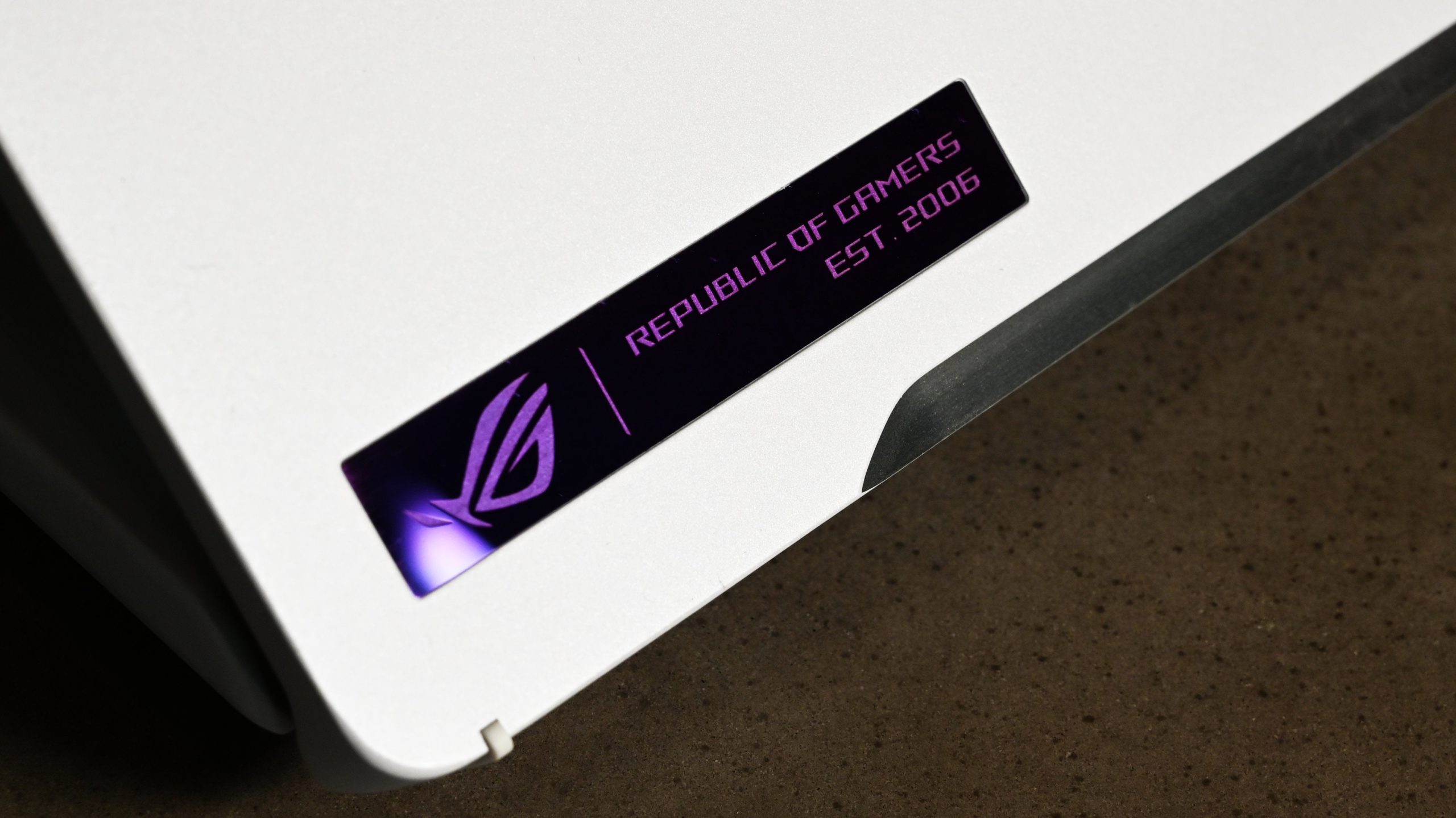
The Zephyrus G14 is perhaps the best all-purpose laptop for those who need a laptop capable of playing the latest games at high frames per second. This latest model is particularly compelling in that it fixes most of the problems plaguing the previous versions. It adds a webcam, shifts to a 16:10 display, and sports a much larger touchpad. What might turn you off are the thermals, which remain a problem despite all the fancy new engineering. And while the Zephyrus G14 starts at $US1,599 ($2,220), the top-end config goes for a not-so-budget-friendly $US2,499 ($3,469).
You could wait for other options to enter the market, like the updated Razer Blade 14, but I won’t blame you for assuming the Zephyrus G14 will be the best gaming laptop of the year — it sure feels like it to me.
